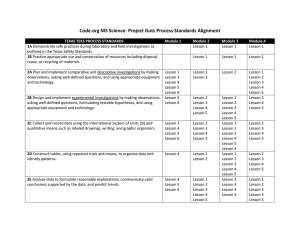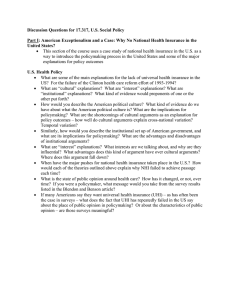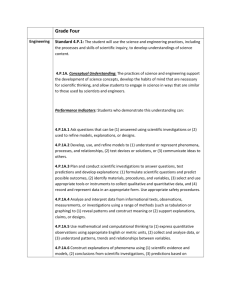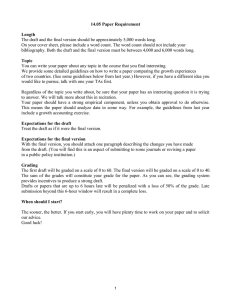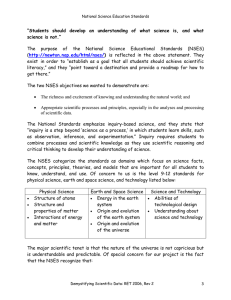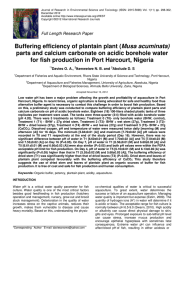SCIENCE Subject/Grade or Course: HS – Physical Science Unit
advertisement
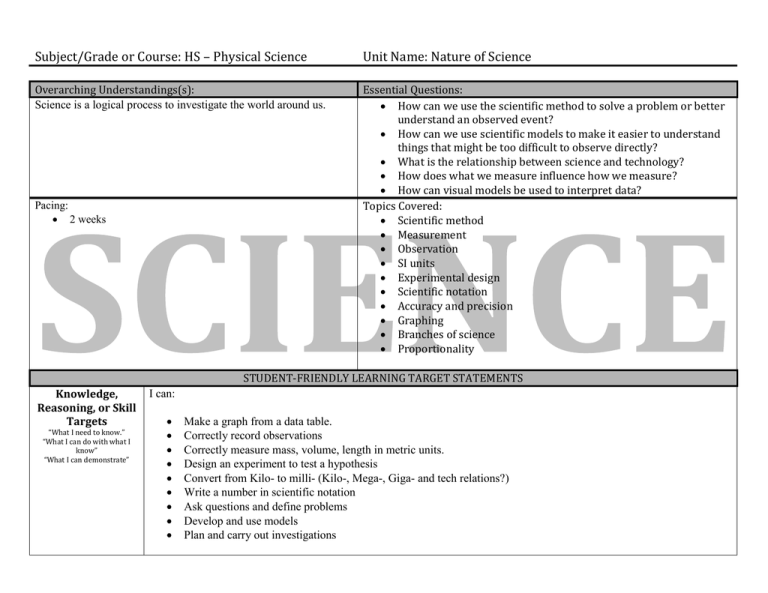
Subject/Grade or Course: HS – Physical Science Unit Name: Nature of Science Overarching Understandings(s): Science is a logical process to investigate the world around us. Essential Questions: How can we use the scientific method to solve a problem or better understand an observed event? How can we use scientific models to make it easier to understand things that might be too difficult to observe directly? What is the relationship between science and technology? How does what we measure influence how we measure? How can visual models be used to interpret data? Topics Covered: Scientific method Measurement Observation SI units Experimental design Scientific notation Accuracy and precision Graphing Branches of science Proportionality Pacing: 2 weeks STUDENT-FRIENDLY LEARNING TARGET STATEMENTS Knowledge, Reasoning, or Skill Targets “What I need to know.” “What I can do with what I know” “What I can demonstrate” I can: Make a graph from a data table. Correctly record observations Correctly measure mass, volume, length in metric units. Design an experiment to test a hypothesis Convert from Kilo- to milli- (Kilo-, Mega-, Giga- and tech relations?) Write a number in scientific notation Ask questions and define problems Develop and use models Plan and carry out investigations Performance Targets: “What I can make to show my learning.” Labs/Activities I can: Design a controlled experiment, collect, graphically represent data, analyze data, form a conclusion, and communicate my results. MATERIALS FOR LESSON PLANNING Measurement stations (mass, length, volume, etc) Design a controlled experiment, collect data, graph results Grow dinosaurs Coke and Mentos 3 hole bottle Penny and water drops Common Assessment Subject/Grade or Course: HS – Physical Science Unit Name: Nature of Science Idaho State Content Standards Corresponding NGSS MS-ETS-ED Students who demonstrate understanding can: e. Refine a design by conducting several rounds of tests, modifying the model after each test, to create the best possible design that meets the most important criteria. [Clarifying Statement: F or example, students refine the design of a model building to withstand an earthquake, strengthening failure points after each test, or refine the design of a water filtration system by adding physical and chemical components and retesting after each change] f. Communicate information about a proposed solution to a problem, including relevant scientific principles, how the design was developed, how it meets the criteria and constraints of the problem, CCSS ELA ELA – RST.6.3 Follow precisely a multistep procedure when carrying out experiments, taking measurements, or performing technical tasks W.6.1 Write arguments to support claims with clear reasons and relevant evidence W.7.1 Write arguments to support claims with clear reasons and relevant evidence W.8.1 Write arguments to support claims with clear reasons and relevant evidence WHST .7 Conduct short research projects to answer a question (including a self-generated question), Standard 1: Nature of Science Goal 1.1: Understand Systems, Order, and Organization 8-9.PS.1.1.1 Explain the scientific meaning of system, order, and organization. (648.01a) 8-9.PS.1.1.2 Apply the concepts of order and organization to a given system. (648.01a) Goal 1.2: Understand Concepts and Processes of Evidence, Models, and Explanations 8-9.PS.1.2.1 Use observations and data as evidence on which to base scientific explanations. (648.02a) 8-9.PS.1.2.2 Develop models to explain concepts or systems. (648.02b) 8-9.PS.1.2.3 Develop scientific explanations based on knowledge, logic, and analysis. (648.02c) Goal 1.3: Understand Constancy, Change, and Measurement 8-9.PS.1.3.1 Measure changes that can occur in and among systems. (648.03b) 8-9.PS.1.3.2 Analyze changes that can occur in and among systems. (648.03b) 8-9.PS.1.3.3 Measure and calculate using the metric system. (648.03c) Goal 1.4: Understand the Theory that Evolution is a Process that Relates to the Gradual Changes in the Universe and of Equilibrium as a Physical State (no objectives in Physical Science) Goal 1.5: Understand Concepts of Form and Function (no objectives in Physical Science) Goal 1.6: Understand Scientific Inquiry and Develop Critical Thinking Skills 8-9.PS.1.6.1 Identify questions and concepts that guide scientific investigations. (649.01a) 8-9.PS.1.6.2 Utilize the components of scientific problem solving to design, conduct, and communicate results of investigations. (649.01b) 8-9.PS.1.6.3 Use appropriate technology and mathematics to make investigations. (649.01c) 8-9.PS.1.6.4 Formulate scientific explanations and models using logic and evidence. (649.01d) 8-9.PS.1.6.5 Analyze alternative explanations and models. (649.01e) 8-9.PS.1.6.6 Communicate and defend a scientific and how it reduces the potential for negative consequences for society and the natural environment. [Clarifying Statement: Students develop a poster, slide presentation, or oral design concept presentation.] [Assessment Boundary: Arguments should be limited to qualitative characteristics.] drawing on several sources and generating additional related, focused questions that allow for multiple avenues of exploration. Mathematics – MP 1 Make sense of problems and persevere in solving them. MP.2 Reason abstractly and quantitatively . MP.4 Model with mathematics. MP.6 Attend to precision. 6.EE Apply and extend previous understandings of arithmetic to algebraic expressions Represent and analyze quantitative relationships between dependent and independent variables. 7.RP Analyze proportional relationship and use them to solve real-world and mathematical problems. 7.EE Solve real-life and mathematical problems using numerical and algebraic expressions and equations. 8.F Use functions to model relationships between quantities. argument. (649.01f) 8-9.PS.1.6.7 Explain the differences among observations, hypotheses, and theories. (649.01g) Goal 1.7: Understand That Interpersonal Relationships Are Important in Scientific Endeavors (no objectives in Physical Science) Goal 1.8: Understand Technical Communication 8-9.PS.1.8.1 Analyze technical writing, graphs, charts, and diagrams. (658.02a)
